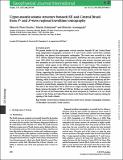Por favor, use este identificador para citar o enlazar a este item:
http://hdl.handle.net/10261/185406COMPARTIR / EXPORTAR:
 SHARE SHARE
 CORE
BASE CORE
BASE
|
|
| Visualizar otros formatos: MARC | Dublin Core | RDF | ORE | MODS | METS | DIDL | DATACITE | |

| Título: | Upper-mantle seismic structure beneath SE and Central Brazil from P- and S-wave regional traveltime tomography |
Autor: | Rocha, Marcelo Peres; Schimmel, Martin CSIC ORCID ; Assumpçao, M. | Palabras clave: | Body waves Seismic tomography Dynamics of lithosphere and mantle South America Mantle processes Inverse theory |
Fecha de publicación: | 2011 | Editor: | Oxford University Press | Citación: | Geophysical Journal International 184(1): 268-286 (2011) | Resumen: | We present models for the upper-mantle velocity structure beneath SE and Central Brazil using independent tomographic inversions of P- and S-wave relative arrival-time residuals (including core phases) from teleseismic earthquakes. The events were recorded by a total of 92 stations deployed through different projects, institutions and time periods during the years 1992-2004. Our results show correlations with the main tectonic structures and reveal new anomalies not yet observed in previous works. All interpretations are based on robust anomalies, which appear in the different inversions for P- and S-waves. The resolution is variable through our study volume and has been analyzed through different theoretical test inversions. High-velocity anomalies are observed in the western portion of the São Francisco Craton, supporting the hypothesis that this Craton was part of a major Neoproterozoic plate (San Franciscan Plate). Low-velocity anomalies beneath the Tocantins Province (mainly fold belts between the Amazon and São Francisco Cratons) are interpreted as due to lithospheric thinning, which is consistent with the good correlation between intraplate seismicity and low-velocity anomalies in this region. Our results show that the basement of the Paraná Basin is formed by several blocks, separated by suture zones, according to model of Milani & Ramos. The slab of the Nazca Plate can be observed as a high-velocity anomaly beneath the Paraná Basin, between the depths of 700 and 1200 km. Further, we confirm the low-velocity anomaly in the NE area of the Paraná Basin which has been interpreted by VanDecar et al. as a fossil conduct of the Tristan da Cunha Plume related to the Paraná flood basalt eruptions during the opening of the South Atlantic. © 2010 The Authors Geophysical Journal International © 2010 RAS. | URI: | http://hdl.handle.net/10261/185406 | DOI: | 10.1111/j.1365-246X.2010.04831.x | Identificadores: | doi: 10.1111/j.1365-246X.2010.04831.x issn: 0956-540X |
| Aparece en las colecciones: | (Geo3Bcn) Artículos |
Ficheros en este ítem:
| Fichero | Descripción | Tamaño | Formato | |
|---|---|---|---|---|
| Schimmel_Geophysical_Journal_International_184_268.pdf | 4,22 MB | Adobe PDF |  Visualizar/Abrir |
CORE Recommender
SCOPUSTM
Citations
60
checked on 19-abr-2024
WEB OF SCIENCETM
Citations
57
checked on 23-feb-2024
Page view(s)
200
checked on 29-abr-2024
Download(s)
177
checked on 29-abr-2024
Google ScholarTM
Check
Altmetric
Altmetric
NOTA: Los ítems de Digital.CSIC están protegidos por copyright, con todos los derechos reservados, a menos que se indique lo contrario.
